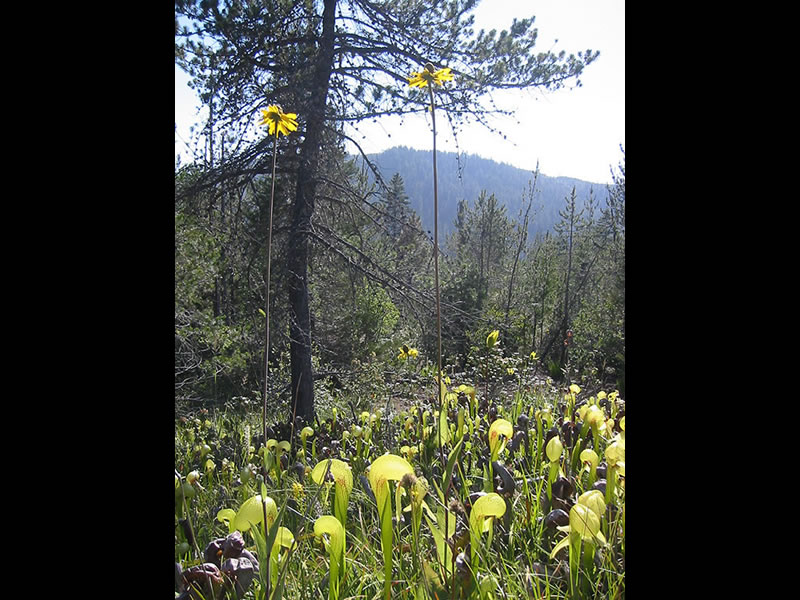Fire Recovery in Darlingtonia Wetlands
In 2002, a lightning caused wildfire burned through the coastal serpentines of the Klamath-Siskiyous, burning up to 500,000 acres. Where there is fire, there is often the opportunity for research. What happens to the structure of plant communities after a fire? How do species or their abundances change? What other factors are affected that influence plant community recovery?
Scientists from Harvard University, University of Vermont, Humboldt State University, and University of Tennessee collaborated on a study to assess the effects of burning on Darlingtonia wetland vegetation and on a food source of Darlingtonia: ants.
In the spring after the wildfire, scientists sampled burned and unburned wetlands. They found that vegetation cover was significantly reduced in burned wetlands, though the number of species (richness) was no different from that found in the unburned wetlands. Vegetation cover had nearly recovered to the levels found in unburned wetlands five years after the wildfire.
 Dr. Erik Jules records a GPS reading in the L. E. Horton Research Natural Area (Six Rivers National Forest) after the Biscuit Wildfire. Photo by Nate Sanders.
Dr. Erik Jules records a GPS reading in the L. E. Horton Research Natural Area (Six Rivers National Forest) after the Biscuit Wildfire. Photo by Nate Sanders.
While plant species richness did not differ between burned and unburned fens, the relative importance of species did change because of fire. For example, Narthecium californicum (California bog-asphodel) was the most abundant plant in unburned fens, but was the fourth most common plant in burned fens. A summary of cover values (percentage) for the most common plants are listed below.
| Species | Unburned Fens Cover (%) | Burned Fens Cover (%) |
|---|---|---|
| Narthecium californicum | 8.9 | 3.6 |
| Darlingtonia californica | 8.6 | 4.4 |
| Sanguisorba officinalis | 8.3 | 7.2 |
| Rudbeckia californica | 8.1 | n/a |
| Carex spp. | 7.8 | 5.9 |
| Ledum glandulosum | n/a | 3.5 |
Ants
Ants are frequently detected prey items associated with Darlingtonia pitchers. What are the effects of fire to this food source for Darlingtonia? What happens to the ant diversity and community structure following fire? What implications might there be for recovery of Darlingtonia wetlands?
In two years of sampling, scientists detected 15 ant species in the wetlands. On average, two ant species occurred in any one unburned wetlands, but three ant species, on average, occurred in burned wetlands. Ant community composition differed strongly between wetlands and adjacent serpentine woodlands and between burned and unburned wetlands. By far, the most common ant in the fens was Tapinoma sessile.
Tapinoma sessile is one of the most widespread ants in North America and occurs in a variety of habitats. It is not surprising that this species also occurs in Darlingtonia wetlands. Tapinoma sessile is also among the most frequently collected prey species in Darlingtonia californica tubes.
The following are lists of ant species that were found in in burned and unburned wetlands:
- Ants collected in burned wetlands: Aphaenogaster occidentalis, Camponotus vicinus, Formica acreta, Formica moki, Formica subelongata, Formica subpolita, Lasius pallitarsis, Leptothorax (muscuroum) sp., Prenolepis imparis, Solenopsis molesta, Temnothorax nevadensis, Temnothorax rudis, Crematogaster coarctata, Tapinoma sessile.
- Ants collected in unburned wetlands: Aphaenogaster occidentalis, Camponotus vicinus, Formica moki, Leptothorax (muscuroum) sp., Lasius pallitarsis, Temnothorax nevadensis, Temnothorax rudis, Myrmica incompleta.
This research was funded by the National Science Foundation.
Definitions
Research Natural Areas - Research Natural Areas (RNAs) provide a long-term network of ecological reserves designated for non-manipulative research, education, and the maintenance of biodiversity. RNAs are designated by the U.S. Forest Service to preserve a spectrum of relatively pristine areas that represent a wide range of natural variability within important natural ecosystems and environments, and areas that have unique characteristics of scientific importance.
Resources and References
Research about the effects of fire on Darlingtonia wetland vegetation and ant communities continues. You may learn more about research results by reviewing the following papers:
- Sanders, N. J., N. J. Gotelli, J. S. Wittman, J. S. Ratchford, A. M. Ellison, and E. S. Jules. 2007. Assembly rules across spatial scales and habitats. Journal of Biogeography 34:1632-1641.
- Ratchford, S. E., Sanders, N. J., J. S. Wittman, E. S. Jules, A.M. Ellison, and N. J. Gotelli. 2005. The effects of fire, local environment and time on ant assemblages in fens and forests. Diversity and Distributions 11:487-497.





